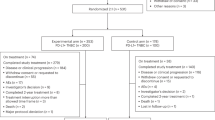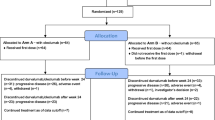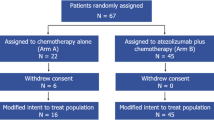Abstract
The purpose of this study was to evaluate in a randomized phase II trial the efficacy and toxicity of combination biochemotherapy compared with chemotherapy alone in patients with metastatic melanoma. Sixty-five patients with metastatic melanoma (ECOG performance status 0 or 1) were randomized to receive intravenous BCNU 100 mg m(-2) (day 1, alternate courses), cisplatin 25 mg m(-2) (days 1-3), DTIC 220 mg m(-2) (days 1-3) and oral tamoxifen 40 mg (BCDT regimen) with (n = 35) or without (n = 30) subcutaneous interleukin 2 (IL-2) 18 x 10(6) iu t.d.s. (day - 2), 9 x 10(6) iu b.d. (day - 1 and 0) and interferon 2 alpha (IFN-alpha) 9 MU (days 1-3). Evidence for immune activation was determined by flow cytometric analysis of peripheral blood lymphocytes. Treatment was repeated every 4 weeks up to six courses depending on response. The overall response rate of BCDT with IL-2/IFN-alpha was 23% [95% confidence interval (CI) 10-40%] with one complete response (CR) and seven partial responses (PR), and for BCDT alone 27% (95% CI 12-46%) with eight PRs; the median durations of response were 2.8 months and 2.5 months respectively. Sites of response were similar in both groups. There was no difference between the two groups in progression-free survival or overall survival (median survival 5 months for BCDT with IL-2/IFNalpha and 5.5 months for BCDT alone). Although 3 days of subcutaneous IL-2 resulted in significant lymphopenia, evidence of immune activation was indicated by a significant rise in the percentage of CD56- (NK cells) and CD3/HLA-DR-positive (activated T cells) subsets, without any change in the percentage of CD4 or CD4 T-cell subsets. Toxicity assessment revealed a significantly higher incidence of severe thrombocytopenia in patients treated with combination chemotherapy than with chemotherapy alone (37% vs 13%, P = 0.03) and a higher incidence of grade 3/4 flu-like symptoms (20% vs 10%) and fatigue (26% vs 13%). The addition of subcutaneous IL-2 and IFNalpha to BCDT chemotherapy in a randomized phase II trial resulted in immune activation but did not improve response rates in patients with metastatic melanoma, and indeed may increase some treatment-related toxicity.
This is a preview of subscription content, access via your institution
Access options
Subscribe to this journal
Receive 24 print issues and online access
$259.00 per year
only $10.79 per issue
Buy this article
- Purchase on Springer Link
- Instant access to full article PDF
Prices may be subject to local taxes which are calculated during checkout
Similar content being viewed by others
Author information
Authors and Affiliations
Rights and permissions
About this article
Cite this article
Johnston, S., Constenla, D., Moore, J. et al. Randomized phase II trial of BCDT [carmustine (BCNU), cisplatin, dacarbazine (DTIC) and tamoxifen] with or without interferon alpha (IFN-α) and interleukin (IL-2) in patients with metastatic melanoma. Br J Cancer 77, 1280–1286 (1998). https://doi.org/10.1038/bjc.1998.214
Issue Date:
DOI: https://doi.org/10.1038/bjc.1998.214
This article is cited by
-
Biochemotherapy with low doses of subcutaneous interleukin-2 in patients with melanoma: results of a phase II trial
Clinical and Translational Oncology (2005)
-
Combination chemotherapy with or without s.c. IL-2 and IFN-α: results of a prospectively randomized trial of the Cooperative Advanced Malignant Melanoma Chemoimmunotherapy Group (ACIMM)
British Journal of Cancer (2002)



